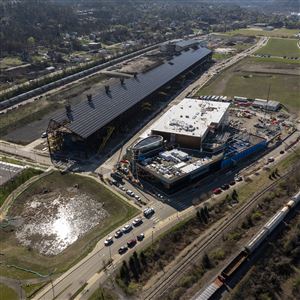The message from the little federal courthouse in Abingdon, Va., was as dramatic as the surrounding Blue Ridge Mountains: The leaders of Purdue Pharma, who had ushered in the OxyContin era of freedom from pain, had misbranded their drug when they claimed it was not addictive.
On that day in 2007, three company executives pleaded guilty to misdemeanors, and the firm committed to pay $635 million for its false marketing of the time-release oxycodone painkiller. John Brownlee, who was then the U.S. attorney for the Western District of Virginia, said their “misrepresentations and crimes sparked one of our nation's greatest prescription drug failures." The settlement was national news.
Seven years later, though, physician Dwight L. Bailey’s signature on an order suspending his medical license showed that even in Lebanon, Va., just 20 miles from Abingdon, the message had not been heeded.
One of his patients had, over seven years, been prescribed 14,640 oxycodone pills and other drugs for back and leg pain and for anxiety and panic attacks, according to a Virginia Board of Medicine investigative report. Dr. Bailey had heard, from an anonymous caller, that the man in his 40s was snorting his pain medications and getting “so messed up that he passes out and burns holes in the couch.” Four months after that warning — and one week after Dr. Bailey’s practice prescribed him 120 doses of Roxicodone, 60 doses of Percocet, 120 doses of Xanax, and 60 doses of Soma, a muscle relaxant — the patient died of an overdose.
Dr. Bailey, who could not be reached for comment, can seek reinstatement of his license later this year.
Even in Abingdon, the damage done by lax prescribing practices continues.
“We’re on our third generation now” of prescription narcotic addicts, said Rebecca Holmes, clinical director at Highlands Community Services, which provides drug rehabilitation in Abingdon. “I would not say that we are getting fewer patients. We’re getting as many, if not more.”
Big regrets
In Virginia, fatal overdoses climbed by 75 percent over five years, and, according to preliminary numbers, drug deaths exceeded 1,000 in 2015. More than half of last year’s record toll was caused by prescription opioids, according to the Virginia Department of Health.
A January report to Virginia’s House of Delegates said the state’s Medicaid program spent $26 million on opioid use and misuse in 2013 and at least 40,000 adults in Virginia’s Medicaid program have a substance abuse disorder.
The Virginia Board of Medicine has responded, disciplining 119 doctors for their narcotics prescribing practices from 2011 to 2015. That’s five out of every 1,000 doctors in the state, a rate that’s second only to Kentucky’s among the seven states studied by the Pittsburgh Post-Gazette in a six-month investigation.
The disciplinary actions may have helped to depress opioid prescribing, which declined by 6.4 percent from 2012 to 2014. That decline, though, was below average for the seven states, and the board’s orders suggest that many practices clung to the no-pain culture fostered by Purdue Pharma prior to 2007.
Randolph Merrick, 61, of rural Orange, Va., helped start a hospice more than 30 years ago, when narcotics were something doctors gave to dying people.
“Then I came across a lot of people with chronic non-cancer pain, created by bad accidents, bad surgery outcomes,” Dr. Merrick told the Post-Gazette. Unlike his hospice patients, these people “were going to live, and they’re totally incapacitated” by pain, he said.
He began using opioids to treat patients with chronic pain, and in the late 1990s helped to write the pain treatment guidelines for the state of Virginia. “People were able to maintain jobs, continue to work, maintain homes, maintain livelihoods,” he said. “That’s success right there.”
The husband of one of his patients, though, saw a downside. The patient, a 35-year-old woman with neck and back pain, was in the care of an addictionologist, being weaned from opioids and Soma, when she came to Dr. Merrick in August 2012, according to a board order from 2014. He told her to quit the addictionologist, and for 20 months prescribed her oxycodone, Soma and Valium.
The patient’s husband wrote to Dr. Merrick, complaining that his prescriptions were causing her to doze off and slur her speech, and as a result she’d lost her job. The husband later called the doctor’s office and “reported that he had observed the patient abusing her medications,” but the prescriptions continued.
An emergency room doctor — whose report made it to Dr. Merrick’s file — checked the patient’s history in the state prescription database, and balked at her request for more drugs.
That database, funded in part with $20 million from the Purdue Pharma settlement, allows doctors to check on their patients’ drug histories. A report on the program, though, showed that doctors were only checking it around 9 percent of the time. A new state law that takes effect July 1 will require prescribers to check the database when prescribing opioids for more than 14 days.
Only in 2014 did Dr. Merrick check the database and learn that his patient had gotten prescriptions for several narcotics from five other medical practitioners, according to the board order.
The board also found problems with Dr. Merrick’s narcotics prescribing to four other patients. It issued a reprimand, placed him on temporary probation, and permanently barred him from prescribing the most powerful controlled substances.
“I thought I was doing the right thing for patients, keeping them working, keeping their quality of life,” said Dr. Merrick. “Come to pass that was considered by the board as not a legitimate reason for prescribing the way I was prescribing. The paradigm was shifting under my feet.”
The alternatives, he said, are unclear, especially since insurers are resistant to paying for physical therapy, injection therapy, and the low level laser therapy he now administers.
He can no longer prescribe narcotic painkillers to dying patients at the hospice he helped found. “That’s tough. Those are my biggest regrets.”
Find another doctor
The prosecutors who charged Purdue Pharma’s executives also went after doctors, including Linda Sue Cheek, of Dublin, Va., population 2,700, just up Interstate 81 from Abingdon.
A jury found Dr. Cheek guilty of 86 counts of unlawful drug distribution, mostly involving the opioid Lortab. Prosecutor Jennie L.M. Waering wrote in a sentencing memorandum that two of Dr. Cheek's patients died of acute prescription drug poisoning. A judge sentenced Dr. Cheek to 27 months in prison, and she was released in March. Her medical license is indefinitely suspended.
On Tuesday, Dublin police Investigator Marty Dowdy looked out his office window at what had been Dr. Cheek’s building. He said the department had just solved a pharmacy robbery in which the perpetrator — an addict — took only the opioid Opana.
Some people “need [narcotics] desperately” for medical problems, he said. “However, there are other people who take half of their prescription and sell the other half. … People are getting it and selling it as fast as they can get it.”
Did efforts to discipline doctors change the black market for the drugs in Dublin? “Honestly,” he said, “they just go to another doctor to get the pills.”
Rich Lord: rlord@post-gazette.com or 412-263-1542. Twitter @richelord. Donna Eyring contributed to this report: deyring@post-gazette.com or 412-263-1472.
Read OVERDOSED: How doctors wrote the script for an epidemic. Email the team at overdosed@post-gazette.com, and read the OVERDOSED blog for more on the Post-Gazette's investigation, readers' stories, and the latest news about the drug epidemic.
First Published: June 2, 2016, 4:00 a.m.
















